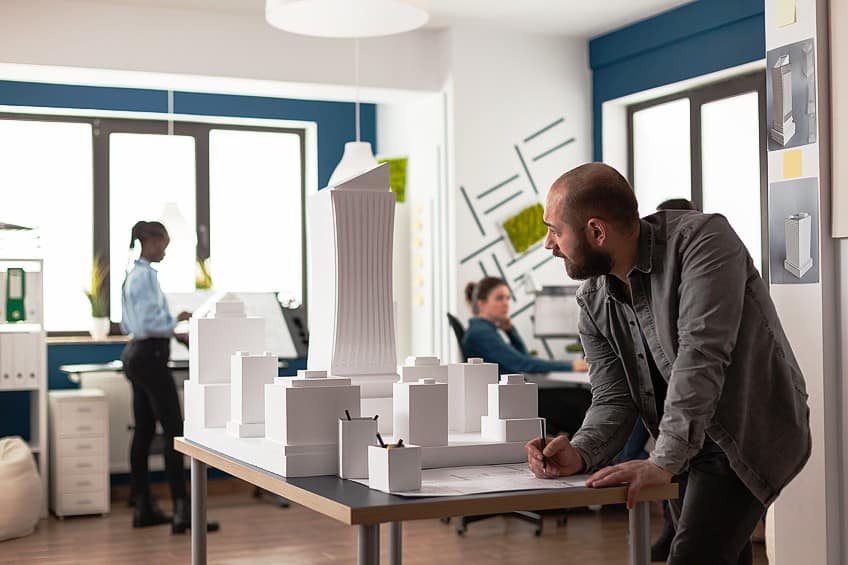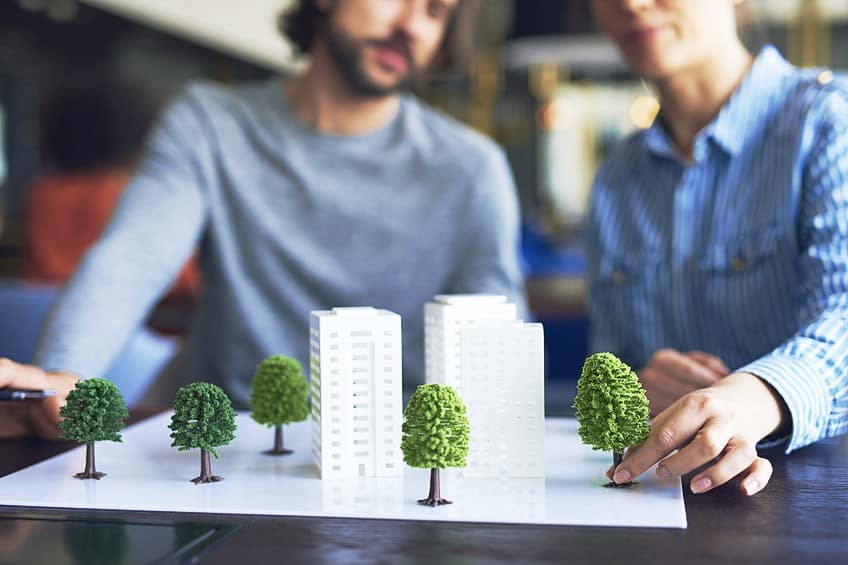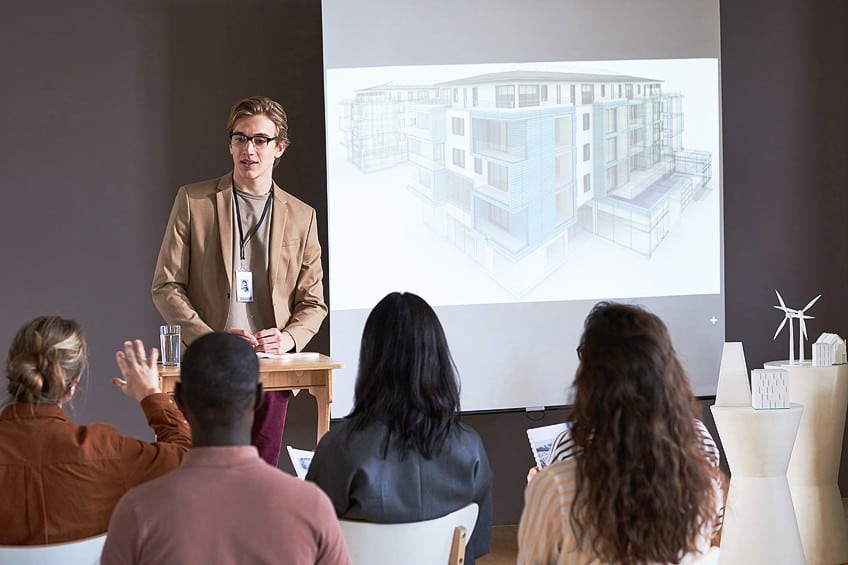Sustainable Architecture – Building a Greener Future
What is sustainable architecture? That is the question that we will be exploring today. In this article, we will examine a number of aspects of sustainability in architecture, such as its history, some of the major principles it is oriented around, the use of green architecture certifications, and much more. If you are interested in learning more about sustainable architecture, then keep reading because there is a lot to learn about this ever-expanding architectural design method!
Table of Contents
- 1 A Look at Sustainable Architecture
- 2 The History of Sustainable Architecture
- 3 Principles of Sustainable Architecture
- 4 Net-Zero Buildings: The Pinnacle of Sustainability
- 5 Green Building Certifications
- 6 Bioclimatic Design: Adapting to Local Environments
- 7 Innovations in Sustainable Construction
- 8 Green Infrastructure: Sustaining Urban Ecosystems
- 9 Eco-Friendly Residential Architecture
- 10 Sustainable Architecture and Community Impact
- 11 Frequently Asked Questions
A Look at Sustainable Architecture
In the most basic terms: what is sustainable architecture? It is an attempt at producing structures that are more environmentally friendly. Buildings that do not use as much electricity, water, and so on. There are many different ways in which eco-architecture designs can be attained and implemented, and we will examine many of those aspects today.
So, let’s get started and have a look at sustainable architecture.
The History of Sustainable Architecture
The origin of sustainable architecture is a rather interesting question to consider. In terms of the contemporary usage of the term, some of the earliest forms of an intentional attempt to be sustainable in terms of the design of structures began in the 1970s. This particular period is notable for the energy crisis that rocked the world and forced a renewed examination of the way in which we were interacting with the environment. However, it can also be argued that sustainable architecture has a bit of a different history overall.
When it comes to an understanding of what a concept like “sustainable” actually means, then sustainability in architecture is actually far older.
Many vernacular styles of architecture, as in the design and construction of more individualized buildings constructed by ordinary citizens rather than governments, religious organizations, and businesses, tended to construct their buildings out of whatever materials were the closest at hand. The use of the closest and most abundant materials can be seen as an early form of a more sustainable approach, in place of shipping materials from distant regions, but it did also lead to overproduction in many locations. For instance, deforestation as a result of the need to acquire as much wood as possible is one of the things that has led to the present crisis in which we as a world now find ourselves.

Some cultures were far more likely to construct more sustainable structures in ancient times, such as Japanese architecture, which was noted for its attempted coexistence with the natural world around it. However, many of these more ancient forms of architecture that could be argued, in a sense, to be a kind of “sustainable architecture” were not done for any ecological reasons as they are now performed.
The advent of scientific methods that have allowed us to understand the impact of industrialization and urbanization on the environment has led to the desire and need for eco architecture.
One of the earliest instances of a direct appeal for a new kind of green architecture could be found in the 1980s when an American architect by the name of Bob Berkebile argued that the American Institute of Architects, or the AIA, needed to re-examine the way in which architecture was approached, taught, and implemented.
In the contemporary era, this need for an eco-architecture has led to the proliferation of a variety of techniques, awards, incentives, and so on to attempt to encourage a move towards greater and greater ecological design. While architecture is still often a highly non-ecological endeavor, there have been increased attempts in some of the largest and most ambitious projects to ensure that designs and construction attempt to achieve net-zero emissions and general sustainability with regard to the materials that are used in construction.
However, there is still a long way to go.
Principles of Sustainable Architecture
In terms of how one approaches an eco-architecture, there are many different principles that should be kept in mind. Sustainability in architecture may be difficult at times, and it does not necessarily lead to any short or long-term benefits for whoever is constructing the ecological building in question but views such as ecological sustainability are not about benefits on a more personalized level. Instead, an attempt at sustainability in general is an attempt to keep the earth and all of its occupants in mind when designing and constructing structures.

Some Active Principles
This does not mean that there is no benefit whatsoever, as there are certain eco-architectural designs that do ultimately reduce expenses, but often require additional upfront costs. For instance, one of the major principles of sustainable architecture is the use of various energy efficiency techniques. This can entail the use of individualized electrical generation, such as through solar and wind power that can be installed for individual buildings.
Methods such as this reduce the need for the building to draw from the communal power grid and thereby leads to a general reduction in the need for additional electrical generation.
This is beneficial to the grid and public as a whole as there is simply less strain on said grid. However, these methods also allow for reduced electricity costs as renewable energy sources do not require the burning of fossil fuels or anything else. If there is wind or daylight, the structure can sustain itself without the need for additional electricity.
Some Passive Principles
In addition to individualized electrical generation, energy efficiency also includes the use of more sophisticated insulation technology, better ventilation, the use of energy-efficient appliances, a reduction in the output of waste, such as through the use of in-house composting, and so on. There are many different ways in which a building can become more efficient along green architectural lines.
Furthermore, other principles of sustainable architecture include the use of more passive design techniques, such as by designing structures in such a way that they maximize light from certain angles, the use of more natural ventilation methods to reduce the need for air-conditioning, and so on.
When a structure is designed as an unventilated box, there is little space for things like the free flow of air through a structure, and this then necessitates the use of high energy consumption devices, such as artificial ventilation systems. And last but not least, the necessity to carefully choose which materials are used in construction is a necessary aspect of sustainable architecture. In many more traditionally constructed buildings, materials can often be imported from around the globe, and this increases the emissions of a structure as the transport of said materials and the emissions associated with that method of transport add to the overall emissions of the structure in question.

This means that more local materials, that can be more easily obtained and transported with a minimized level of emissions, are inherently more sustainable. Furthermore, there are biodegradable and recycled materials that can be used instead of simply producing more, which can often mean strip mining entire mountains or cutting down whole forests.
All of these principles together contribute to the way in which sustainable architecture should be approached.
Net-Zero Buildings: The Pinnacle of Sustainability
What is a net-zero building? This term has already been mentioned in passing, but what is it in more specific terms? What must be understood is that it is generally impossible to construct anything while remaining perfectly environmentally friendly. For instance, the transport of materials will always lead to emissions unless steel beams and huge shipments of wood could somehow be transported without vehicles. However, constructing something like that would be akin to the way in which Stonehenge was constructed, and no one is interested in recreating that construction experience in the modern day.
So, ultimately, buildings need to look at net-zero emissions rather than gross-zero emissions.
Gross-zero emissions would mean a design that was completely free from emissions, which is impossible as all materials have to be acquired from somewhere, and even if we replant forests for lumber, the cutting down of trees or taking minerals from the earth is fundamentally anti-environmental. This means that other methods need to be implemented to offset those emissions. These offsets often entail aspects such as constructing a building that will then be taken off the electrical grid because it can produce its own electricity. The reason that this is an example of net-zero design is because while the creation and installation of renewable energy devices require emissions, once it is implemented, it no longer produces any emissions.

It may be environmentally damaging, in a reduced capacity, to mine for the materials needed in solar panels and to then transport them, but at least once they are installed, there will no longer be any emissions from that building. To achieve a net-zero status, the principles of sustainable architecture that were mentioned above need to be adhered to as the use of electricity, sewer systems, and so on all contribute to total environmental damage. This means that the idea behind a net-zero design is to minimize the amount of damage that is being inflicted rather than completely remove the damage.
It can be seen as a utilitarian approach: reducing damage as much as possible rather than removing damage completely.
Green Building Certifications
Do people engage in sustainable architecture simply because it is the right thing to do? Not necessarily. Some of us might do this if we ever get the chance to construct our own homes, but this is not usually the case. Instead, there are a number of incentives in place to coerce designers and construction firms to aim for sustainability in architecture.
Some of these methods can involve tax cuts or repayments for implementing renewable energy solutions in a structure’s design. However, another incentive is through the use of certifications.
Certificates are inherently appealing. We are fascinating creatures, and if we have a special piece of paper that says we have done something good then this is a way to exhibit our adherence to something good (or as a means of flexing a supposed superiority). For instance, the Leadership in Energy and Environmental Design, or LEED, an initiative within the US Green Building Council provides certificates to buildings that have attained a certain level of sustainability in architecture, such as through the use of renewable energy, water efficiency, and reduced emissions.

This is probably the most famous of these certifications, but there are also others, such as the UK-based Building Research Establishment Environmental Assessment Method (BREEAM) certificates or the Green Star certificates which can be found throughout Africa. All of these certifications are means of symbolically rewarding constructions that adhere to sustainable architecture trends. These certifications are also often placed front and center when large projects advertise themselves as green architecture.
While necessary, is also considered to be somewhat in vogue as it simply looks good to employ sustainable methods when designing and constructing buildings.
Bioclimatic Design: Adapting to Local Environments
When it comes to sustainable architecture, the environment itself needs to be taken into account, and bioclimatic design is one of the most fascinating aspects of this. This design ethos involves the construction of buildings around the environment in which it exists, and this entails the use of different methods and materials than is generally considered standard.

This can involve the orientation of a structure so that it best maximizes the amount of natural light and heat that it attains, but it can also include the use of biophilic designs, such as green walls and green roofs (both of which involve the growth of vegetation for both thermal and aesthetic purposes on surfaces).
Innovations in Sustainable Construction
Some of the most innovative aspects of contemporary sustainable architecture have included methods such as 3D printing, which has allowed for carbon-neutral designs of very specific shapes and types of materials, and it also massively reduces waste as 3D printers do not produce any additional elements other than what has been designed.
This reduction in wastefulness is one of the most important aspects of the design of green buildings. In addition to this, recycled and upcycled materials have become more prominent than ever before.
This can entail the use of materials made from existing waste materials or the use of materials that have been reused in some or another sense, such as the use of eco-bricks. Furthermore, technology has come a very long way, and we now have smart technology that can, for instance, regulate interior heating by constantly adjusting air flow levels.
Green Infrastructure: Sustaining Urban Ecosystems
Some of the most fascinating contemporary examples of green architecture include the use of more vertical elements to decrease the amount of space that is used, such as through vertical gardens and urban farming. In addition to this, the use of rainwater harvesting and better management of the water that is being used is of integral importance for the development of more sustainable spaces.

In terms of a more urban level, some of the most useful methods of maintaining urban ecosystems are through the use of additional green spaces and non-motor vehicle lanes, such as pedestrian and bicycle roads. The goal is to improve the general well-being of the people who live within cities, and that is best attained through sustainable architecture and the many methods that can be adopted.
Eco-Friendly Residential Architecture
When we think of cutting-edge architecture, we tend to think of large and impressive projects. We think of skyscrapers and massive commercial centers, but sustainable architecture can also be found in residential architecture. There are many ways in which this kind of design can be found and implemented on a far smaller scale. The use of similar techniques, such as passive designs that improve ventilation and insulation, the orientation of structures to increase or decrease sun exposure, and so on can be implemented.
In addition to this, the idea of off-grid structures has gained traction, with houses being removed from electrical grids and producing their own electricity through renewable energy solutions, or the use of water conservation methods, such as rainwater harvesting.
These kinds of solutions, alongside renovation and retrofitting, in which existing houses are either renovated to improve sustainability or aspects are added such as solar panels, have become far more prominent than ever before. While these aspects do tend to be quite expensive, their cost has reduced in recent years and will likely continue to reduce in the years to come.
Sustainable Architecture and Community Impact
When it comes to sustainable architecture, it is important to also take the local community around which the structure is built into account. One of the central aspects of sustainable design is that it is meant to be a more inclusive and health-oriented design. The use of various sustainability principles leads to a reduction in emissions, and this leads to a reduction in pollution, and this ultimately contributes to the well-being of regular people.
In addition to this, many aspects of sustainable architecture also incentivize the use of spaces that are more welcoming to everyday people or those who have specific needs.
For instance, sustainable architecture tends to be oriented around accessibility, and so disability access is baked into the design itself. Furthermore, many structures built around sustainable methods include public spaces, such as public parks and plazas, around buildings. These kinds of community designs allow for the addition of green spaces within urban environments, which is important, but it also allows for spaces in which community activities can be performed. A splash of nature in the middle of the city is better than the endless concrete that tends to be associated with cities. In fact, these kinds of green zones are also for safety reasons, as the present devastation caused by natural disasters, such as floods, is often because of the prolific use of non-porous materials like concrete and asphalt.

When a flood happens, there is nowhere for the water to drain, and so it devastates whole cities. These kinds of green zones can aid in reducing that kind of devastation. However, these elements have only elaborated on larger constructions that would otherwise use excessive amounts of materials and emissions, but these kinds of designs, when used in these larger projects, can influence smaller designs. This means that the construction of sustainable housing, either through retrofitting or new constructions, is more readily available than ever before. Energy-efficient designs are cheaper than ever before, and this means that more widespread adoption in smaller projects will hopefully pick up over the coming decades.
Sustainable architecture is one of the most important aspects of contemporary design because of its immense importance in reducing our emissions and wasteful designs. This article has examined a number of aspects of sustainability in architecture, from its history and principles to its uses in residential spaces. Hopefully, you have learned something about sustainable architecture today, but it should always be remembered that we still have a long way to go before we have achieved a truly sustainable future.
Frequently Asked Questions
What Is Sustainable Architecture?
Sustainable architecture is not any single architectural style, but rather a method. This method entails the use of more energy-efficient solutions, local materials, reduced-emission methods, and so on to design structures that decrease the contribution of said building to climate change. In addition to this, sustainable architecture is generally oriented around the health and well-being of inhabitants and those around the building too.
What Is the Goal of Sustainable Architecture?
The goal of sustainable architecture is to attempt to minimize the environmental impact that buildings have on our world. This can entail using materials that do not need to be transported as far, and thereby reducing the emissions in their transportation, the use of renewable energy so that a building does not draw from the electricity grid, and so on. All of these methods contribute to a reduced environmental impact of the buildings in question.
How Does Sustainable Architecture Contribute to Environmental Conservation?
Sustainable architecture is not a perfect thing, but it contributes to environmental conservation through a number of methods. Buildings that are constructed using green architecture methods use less electricity and water, they promote renewable energy usage, they are designed around long-term design and thereby conserve natural resources, and so on. There are many different ways in which sustainable architecture contributes to the conservation of the natural world, but this has been a short list of some of those methods.
Is Sustainable Architecture Only Suitable for New Buildings?
Sustainable architecture is not a method confined to the design and construction of new buildings. The retrofitting of older structures is also possible. This entails the installation of aspects such as solar panels or wind turbines where they had not existed before to reduce electrical usage. Additionally, buildings can be renovated to make use of better insulation, ventilation, and so on.
What Is the Most Famous Example of Sustainable Architecture?
Some of the most famous examples of sustainable architecture include the Edge in Amsterdam, Netherlands, the Eden Project in Cornwall, United Kingdom, and the Bullitt Center in Seattle, United States. However, there are many other structures that fall under the general purview of sustainable architecture, and the number of said buildings is rising every single year.
Justin van Huyssteen is a freelance writer, novelist, and academic originally from Cape Town, South Africa. At present, he has a bachelor’s degree in English and literary theory and an honor’s degree in literary theory. He is currently working towards his master’s degree in literary theory with a focus on animal studies, critical theory, and semiotics within literature. As a novelist and freelancer, he often writes under the pen name L.C. Lupus.
Justin’s preferred literary movements include modern and postmodern literature with literary fiction and genre fiction like sci-fi, post-apocalyptic, and horror being of particular interest. His academia extends to his interest in prose and narratology. He enjoys analyzing a variety of mediums through a literary lens, such as graphic novels, film, and video games.
Justin is working for artincontext.org as an author and content writer since 2022. He is responsible for all blog posts about architecture, literature and poetry.
Learn more about Justin van Huyssteen and the Art in Context Team.
Cite this Article
Justin, van Huyssteen, “Sustainable Architecture – Building a Greener Future.” Art in Context. September 15, 2023. URL: https://artincontext.org/sustainable-architecture/
van Huyssteen, J. (2023, 15 September). Sustainable Architecture – Building a Greener Future. Art in Context. https://artincontext.org/sustainable-architecture/
van Huyssteen, Justin. “Sustainable Architecture – Building a Greener Future.” Art in Context, September 15, 2023. https://artincontext.org/sustainable-architecture/.









